Criminally Underrated
(a new series in which I highlight and discuss films, TV, music or games worthy of your attention that don't get enough time in the limelight)
3. Persona 4
With Persona 5 (the latest entry in Atlus’ much beloved cult series, which itself is a spin-off of the long running Shin Megami Tensei series) literally just around the corner, I thought it would be a prompt time to look back at the last entry in the series, Persona 4 aka one of the greatest video games of all time. I have decided to put Persona 4 under the Criminally Underrated label as, while it has a loyal fan base (mostly otakus and anime fans) it has yet to break into mainstream consciousness as one of the all time greats. However, amongst those in the know, Persona 4 is often ranked extremely high. With pundits expecting that Persona 5 could be the entry that breaks through, there's no better time to cast a light back on this critically acclaimed entry.
Persona 4 follows the adventures of an average high-schooler (i.e., the player character) as he moves to the countryside town of Inaba. Here he lives with his uncle, a cop, and his younger cousin, Nanako. The player-character begins to navigate the highs and lows of teenage life as he balances school work and social time with his new friends, a wonderful cast of colourful, interesting and loveable characters. However, as you soon discover, this is no normal town. A strange TV program, known as the Midnight Channel, is transmitted at midnight on certain days of the month. The Midnight Channel has a new subject with each screening, normally someone with a close connection to Inaba, where, in a trance-like state, they reveal their darkest secrets. To further add to the problem these people turn up murdered the next day. The player-character and his gang of friends soon learn there is a connection between the Midnight Channel and a portal to a bizarre world they discover hidden in a TV screen. The gang embark on a mission to uncover the mystery of the murders, solve the secret of the Midnight Channel and the world behind the TV and hopefully pass the semester. Stranger still, the player-character has recurring dreams about a mysterious Velvet Room, where some very odd characters warn that you only have a year to solve the case...
 |
| Your unforgettable party (l:r) Kanji, Rise, Yosuke, Yu (player-character), Yukiko, Chie, Teddie, Naoto |
Persona 4 was originally released on the PlayStation 2 back in 2008, literally on the cusp of the new console generation. It was created by the same team as Persona 3 and several new hires who were fans of the previous game. Director Katsura Hashino made a conscious effort to make this new game different to Persona 3, by improving the story-telling and gameplay. This is Persona 4’s first major accomplishment- the tone. The way Persona 4 balances conflicting tones, and the gameplay fallout from this, is exemplary. While Persona 3 handled much darker material, Persona 4 is much lighter in comparison, with some dark undertones. On the one hand, you have a comedic, and often drama-filled, high school storyline to experience. However, there is also a dark murder mystery to solve. The two conflicting tones shouldn't work. However, because of the brilliant writing, you become invested in the characters (understanding their day-to-day life and worries) so when the dark stuff kicks in, we truly do feel for the characters. When an individual appears on the Midnight Channel, there is usually a passage of time until the murder occurs. The murders seem to occur after an unseasonably heavy bout of rain turning into fog. This gives the gang an opportunity of a few days to venture into the TV and launch a rescue mission (as the victims are trapped in the TV world). This gives a ticking time bomb element to proceedings. The gang can venture into the TV to save those trapped on the Midnight Channel but first must complete an intimidating dungeon, usually tailored to the captor’s personality and hidden secrets.
 |
| Exploring one of the vast dungeons |
The central tenant of the game is the brilliant Social Link system. With this, the game actively rewards you for taking time out of your busy schedule to explore Inaba and to get to know the characters. After a lengthy 5 hour opening section (trust me, stick with it) you are let loose in Inaba. These interactions can range from dates at the mall, uncovering a new side-quest or a simple conversation where we learn new depths to the characters. In addition to getting to know the characters, you can spend time pursuing hobbies, holding down a part-time job, work towards earning a scooter licence to venture further afield or take part in after-school activities. Or you might want to spend your days staying inside and studying for that upcoming exam. Or you can ditch the exams and train to tackle the tricky dungeons. This all helps to give a real lived in feeling to the world. Inaba is small but the way Persona 4 lets you play the day-to-day life of your character, you eventually feel at home. While there is a set limit on what you can do per day, there is a lot of variety to the activities you can do, all of which will have a positive impact on building your character up. So you gravitate to what you enjoy. With so many characters and hidden side-stories to uncover, there is plenty of replayability here. The stroke of genius is that by taking time to complete the side-quests and interact with the characters, this is actively helping you in tackling the dungeons. This is where the reward of investing time in the characters begins to pay off on a gameplay level. When the player-character first ventures into the TV, he unlocks the power to summon Personas, powerful ethereal beings that can bestow great power while in combat. Each Persona has a unique set of abilities that the player-character can use. There are dozens of the creatures to find, found mostly through random loot cards at the end of battles or in chests hidden in the dungeons. All of them have brilliant art designs, which range from cute to epic. There is a good mixture of original designs and creatures inspired by mythology and ancient religions. While the other members of your party are stuck with one Persona, the player-character can swap and change between them, creating a great deal of flexibility and experimentation.
 |
| Over the course of the game you can increase stats, such as Knowledge, to help your day-to-day life in Inaba and unlock new sections of the Social Link side-quests |
 |
| Inaba is quaint and small. You will soon feel a great sense of attachment here. |
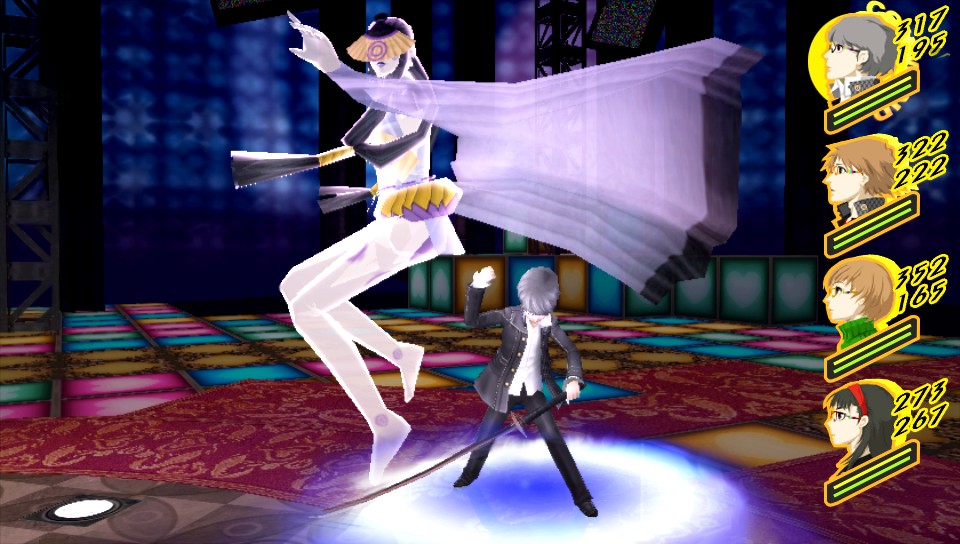 |
| There are dozens of Persona to find and use in combat, all with varying different styles |
This is where the Social Links come into play. Powering up Personas work in traditional RPG terms. You gets into random battles, you fight through turn-based combat, win and gain experience points. However, Persona 4 gives you the opportunity to improve upon the creatures through Fusion. Fusion allows the player to blend two or more Personas together to create a more powerful being and is directly linked to your Social Link. All the characters you can interact with have an attribute linked to them, which is also in turn linked to a mixture of different Personas. The more you interact with the characters and improve your Social Link level, the more powerful your creatures become through fusion. For example, Chie is linked to the Chariot Social Link. This means the more time you spend interacting with Chie the more the Chariot Social Link ranks increases. This will give Chie new abilities with each ranking to use in combat. However it also has the added benefit that when you fuse to create a new Persona that comes under the Chariot ranking, the more experience can be bestowed upon them (depending what level the Social Link is at). This gives a massive EXP boost and allows you to create some of the most powerful Personas in the game.
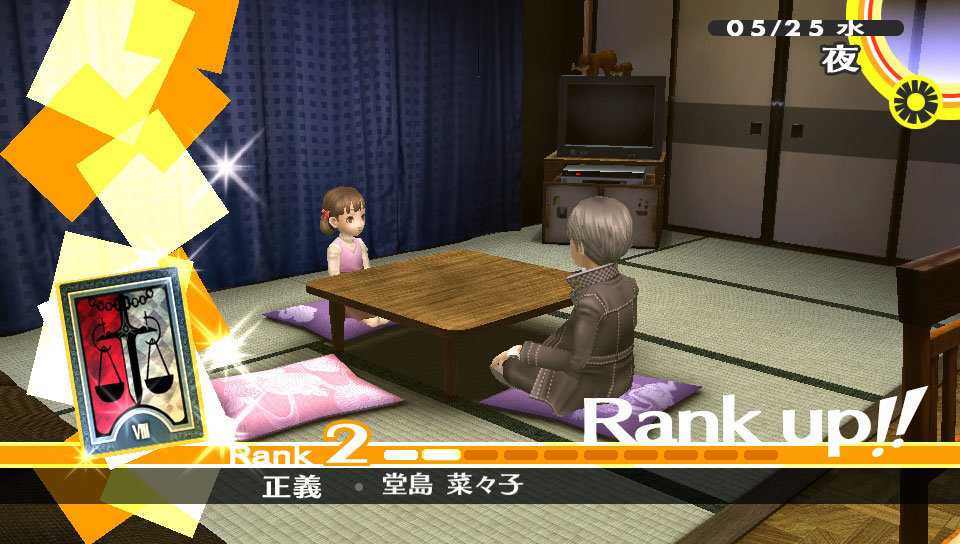 |
| The more time you spend getting to know the characters the more your Social Links will increase |
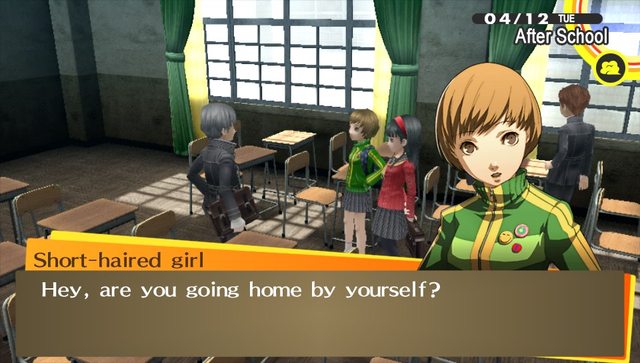 |
| Persona 4 also has a handful of characters you can form a romantic relationship with. I chose Chie. |
So, Persona 4 offers a simple yet endlessly deep combat and levelling up system, that works hand-in-hand with the story telling and character development. Brilliant. But the true heart of the game lies with the characters and more specifically your party. The party that you slowly form over the 60 hour plus experience is one the greatest in the genre. They are given clear personalities, with some complications, and are ultimately positive characters. This is something often lacking in JRPGs, as protagonists tend to sway toward the dark, tortured side. Persona 4’s characters feel real. Sometimes they’re goofy, sometimes they’re serious, sometimes they're sad and sometimes they're high on life. The way the game beautifully interweaves the characters’ wants and needs is something to behold. The social interactions only work to strengthen our bond with them. And they are truly unforgettable. There's Yusuke, the loveable goof trying to live up to his father’s legacy. There's the boisterous Chie, the rough-and-tough no-nonsense member of the group who loves kung-fu. And we can't forgot about the bookish Yukiko, struggling to balance academics while running the family hot spring. Hot-headed (but secretly sensitive) punk Kanji provides the brawn while the mysterious Naoto, young detective wonder, provides the brains. To bring some brightness into grim situations is the teen pop-idol sensation Rise, taking time out of her celebrity lifestyle to lay low for a while. And, finally, the game’s mascot, the awkwardly adorable Teddie, who is both hilarious and surprisingly tragic. Over the course of the game’s epic run time you will grow to love these characters. Their connection with the player-character feels earned and, as the credits begin to roll, you might even find yourself with a tear in the corner of your eye as you say goodbye to this beloved gang. Ultimately, Persona 4 is about how people can come together and help one another to become better individuals.
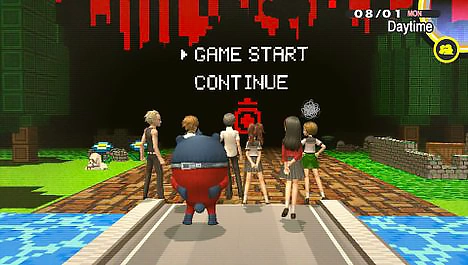 |
| The united party |
Of course, one of the major selling points of Persona 4 is its style. Backed by a brilliant soundtrack of original J-Pop and rock songs, Persona 4 effectively feels like you have walked into a living anime world. There is a livlinesses to the setting, which is further communicated through a handful of anime cutscenes. The town of Inaba also feels alive, as different seasons come and go (and you can interact with all the Japanese holidays, as special events occur in the town). While the basic blocks of the town feel primitive today, you do become slowly affectionate towards the town. This is also to contrast the bright and bizarre dungeons you venture into. As mentioned earlier, each dungeon is a manifestation of the kidnapped victim. For example, Kanji’s dungeon is a manifestation of his confused sexuality (a major breakthrough in the representation of LGBTQ characters in JRPGs, something the genre often shies away from). A blocky 8-bit video game world is the manifestation of a deceased mind of a geek. You get the picture. Each one has a unique design, even if the layout ends up feeling a bit familiar. You’ll spend a lot of time in the dungeons but the brilliant art style on both the location and the creatures you encounter will keep you more than entertained. The graphics hold up ok, particularly if you're playing on the Vita, but the strength of the gameplay and the writing more than make up for now basic sprites.
 |
| Inaba changes throughout the course of the year and lets you experience traditional Japanese festivals |
The influence of Persona 4 is unmissable. The fact that Altus have spent so long preparing Persona 5 is a testament to this (almost 10 years). There have been several spin-offs including a full length anime series (which gives a bizarre personality to the blank slate player-character), a manga series, several spin-off video games, including a strange dance rhythm game (and oddly serves as a full on sequel), various toys, plushies, soundtracks and more. The game clearly made its mark on the group of fans who first discovered it on the PlayStation 2. Persona 4 continued to find new fans when it was ported to Sony's underrated handheld system, the Vita, in 2012. And this is where Persona 4 truly found a second coming. Most RPGs have to be played on a home console. Due to the sheer size of these kind of games, they simply can't fit onto a handheld cartridge. However, for busy adults, this can mean investing less time than what you might have done as a teenager. And this is where the handheld version of Persona 4 comes in (dubbed Persona 4 Golden). The game's mechanics make it perfect as a game to play on the go. I'll play a couple days in the game while I'm waiting for my train. Ah hell, I’m in the middle of a dungeon and I'm about to arrive at work. But it's ok – the brilliant long battery life of the Vita’s standby mode means I can pick up on this at lunch. You get the picture. The bite size nature of the game means it's easier to get invested than on the PlayStation 2. Heck, I know I wouldn't have been able to finish the game in the time that did if I played it on a home console. It's probably the best handheld gaming experience I have ever had. Returning fans can also enjoy new dungeons, a whole new character and accompanying side-quest, several visual and gameplay improvements, a whole batch of new Personas and the promise of the true ending. Persona 4 Golden is one of the greatest ports of all time and is the definitive experience of the game. Atlus. Please make Persona 3 Golden.
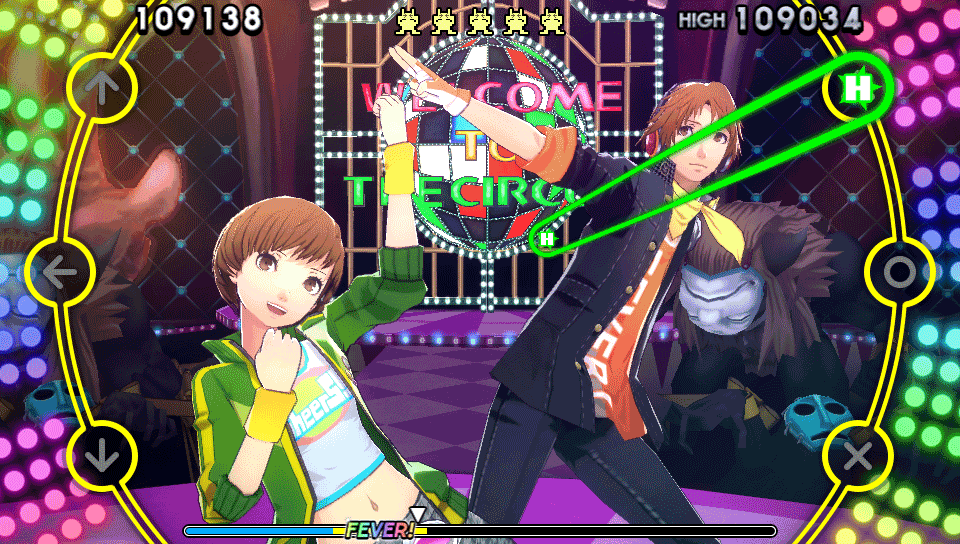 |
| One of the stranger spin-offs - Persona 4: Dancing All Night for the Vita |
 |
| Persona 4 Golden was released to critical acclaim and renewed interest in the series. It is seen as one of the best games for Sony's underrated console, the Vita |
My final thoughts on Persona 4 are simply that it is an unmissable game. I honestly don't feel that words can effectively communicate the amount of affection and love I have for this game. The fact is, video game journalists are quick to write off the JPRG genre as antiquated. Some games do seem to fall into this view (mentioning no names) by sticking to the same tired formula. Persona 4 and the wider series shows that there is still a beating heart left in the genre. My hope is that Persona 5 will start to bring people back round to the idea of quality JRPGs. For this series emphasises experimentation, traditional RPG gameplay and brilliant writing to create unforgettable experiences. With Final Fantasy XV breaking into the mainstream the way it did, I hope those same people will buy Persona 5 to show to developers that this is still a viable genre. But even if it doesn't, those in the know will have a brilliant series of games to enjoy, with Persona 4 as the kind of the lot. Simply put, anyone who calls themselves an RPG fan owes it to themselves to play Persona 4. It's addictive, heart-felt and offers endlessly deep gameplay. An essential.
Rating: 10/10



No comments:
Post a Comment